Those mighty muscles at the back of your thighs? Those are your hamstrings – your very own leg superstars. They’re the muscle MVPs when you’re walking the dog, sprinting for the bus, jumping for a basketball, or even just bending to tie your shoes. They’re the engine room of your lower half, boosting your athleticism with their strength and suppleness.
However, it’s all too easy to neglect our hamstrings, as the spotlight often falls on more showy muscles, like the quads and calves. This uneven focus could land you with an unwanted injury, so giving your hamstrings the attention they deserve is key to a body that’s balanced, agile, and robust.
This article is your ticket to the world of hamstring workouts. We’re going to start off by getting to grips with what makes up your hamstrings and why weaving hamstring workouts into your leg day is so crucial. Next, we’ll walk you through some key safety tips and the need-to-knows of perfect form to help you perform these exercises correctly.
Now let’s dive into four essential hamstring workouts, complete with step-by-step guidance and a list of pitfalls to sidestep. To wrap up, we’ll chat about how to smoothly slot these workouts into your regular leg day. So, strap in and let’s power up those hamstrings!
Understanding the Hamstrings
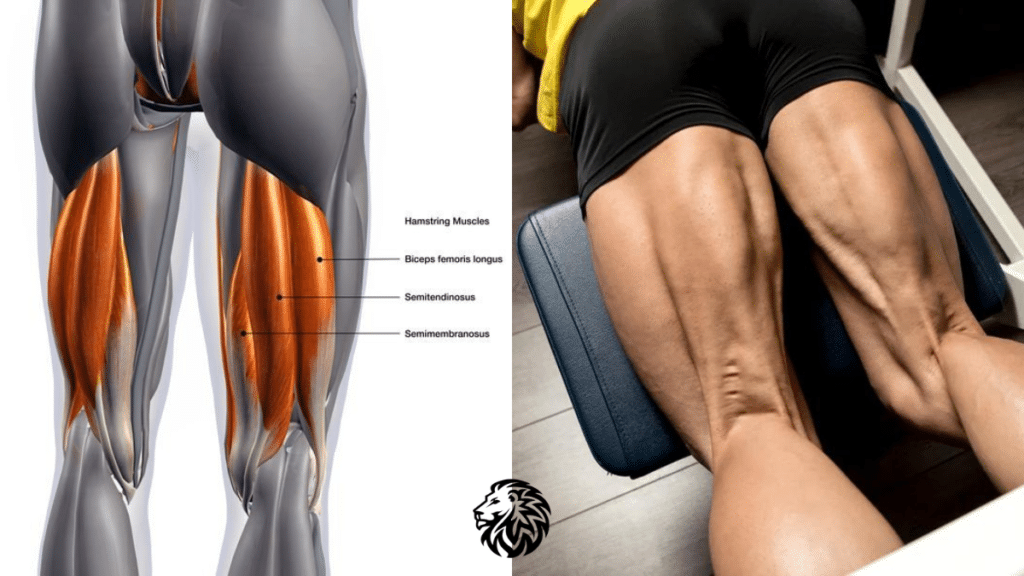
Brief Anatomy of Hamstrings
The hamstrings aren’t just one muscle, but a fantastic trio positioned at the rear of your thigh, stretching all the way from your hips down to your lower leg. This team includes the Biceps Femoris – which boasts a long and a short head – as well as the Semitendinosus, and the Semimembranosus. With these muscles spanning across both the hip and knee joints, they’re the unsung heroes in hip extension and knee flexing.
Function and Importance in Daily Life and Sports Performance
Hamstrings are indispensable for various everyday activities such as walking, running, standing up from a seated position, and climbing stairs. In sports, they’re vital for activities requiring explosive movements, such as sprinting, jumping, and changing direction quickly. Hamstrings also aid in maintaining posture and stability, preventing us from falling forward while standing or walking. Furthermore, they provide balance to the powerful quadriceps muscles at the front of the thigh, ensuring that the forces around the knee are evenly distributed.
Common Issues Arising from Weak or Imbalanced Hamstrings
Skipping out on hamstring training can lead to muscle imbalances, particularly between your hamstrings and quads. This is often referred to as “quad dominance”. This imbalance can lead to undue strain on the knee joint, contributing to conditions like Anterior Cruciate Ligament (ACL) injuries. Furthermore, weak hamstrings can contribute to lower back pain as they are unable to provide adequate support to the pelvis and spine. For athletes, inadequate hamstring strength can lead to reduced performance and a higher risk of hamstring strains or pulls.
Preparation and Safety Measures Before Performing Hamstring Exercises
Warm-ups and Stretches
Like any other muscle group, the hamstrings need to be adequately warmed up before engaging in intense exercise. This process increases blood flow to the muscles. This prepares them for the stress of the workout and reducing the risk of injury. A warm-up can consist of light aerobic activity like jogging or cycling for 5-10 minutes. This should be followed by dynamic stretches such as leg swings and lunges to increase mobility. After the workout, static stretching can help promote flexibility and recovery.
Maintaining Proper Form and Posture
Correct form is crucial when performing hamstring exercises to ensure that the muscles are effectively engaged and to prevent injury. Each exercise has its own specific form, but general guidelines include maintaining a straight back, engaging your core, and moving through a full range of motion. It is important to avoid rounding your back or locking out your knees. When in doubt, it’s always better to use lighter weights or perform fewer repetitions while maintaining proper form.
Tips for Avoiding Injury
Beyond warming up and maintaining proper form, it’s important to listen to your body during your workout. If you feel sharp pain during an exercise, stop immediately and seek medical advice if needed. Always progress gradually with the weights and volume of your workouts to allow your body to adapt. Hydrate adequately and ensure proper nutrition for optimal muscle recovery. Lastly, remember that rest is just as important as training – it’s during rest that your muscles rebuild and strengthen.
Top 4 Crucial Hamstring Exercises
Exercise 1: Romanian Deadlift
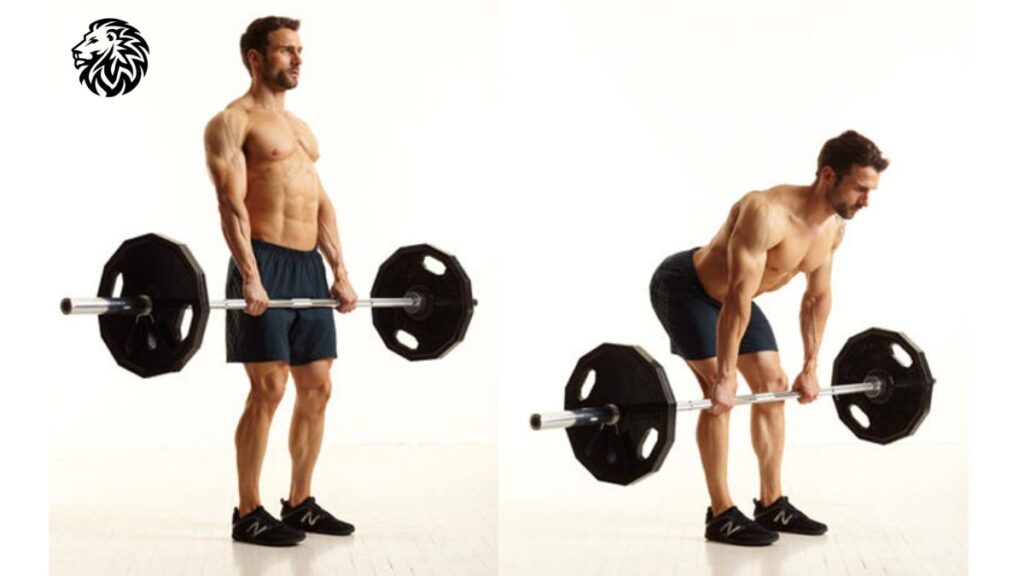
Equipment Needed: A barbell with adjustable weight plates according to your strength and comfort level.
Step-by-step Guide:
a. Stand with your feet hip-width apart, with the barbell in front of you on the floor.
b. Bend at the hips and knees to grab the barbell with an overhand grip, hands just outside of your knees.
c. Straighten your back, lift your chest, and then stand up, pulling the barbell up along your legs.
d. Once you are standing fully upright, push your hips back and bend at the knees to lower the barbell along the same path, maintaining a straight back throughout.
e. Lower the barbell until you feel a stretch in your hamstrings, then reverse the movement by pushing your hips forward and standing up straight.
Common Mistakes and How to Avoid Them:
a. Rounding the back: Ensure your back is straight and your chest lifted throughout the exercise to prevent back strain or injury.
b. Using the back to lift: The power should come from your hamstrings and glutes, not your back. Make sure you’re hinging at the hips.
c. Locking the knees: Keep a slight bend in your knees during the movement, especially when you’re in an upright position, to avoid joint stress.
Exercise 2: Lying Leg Curls
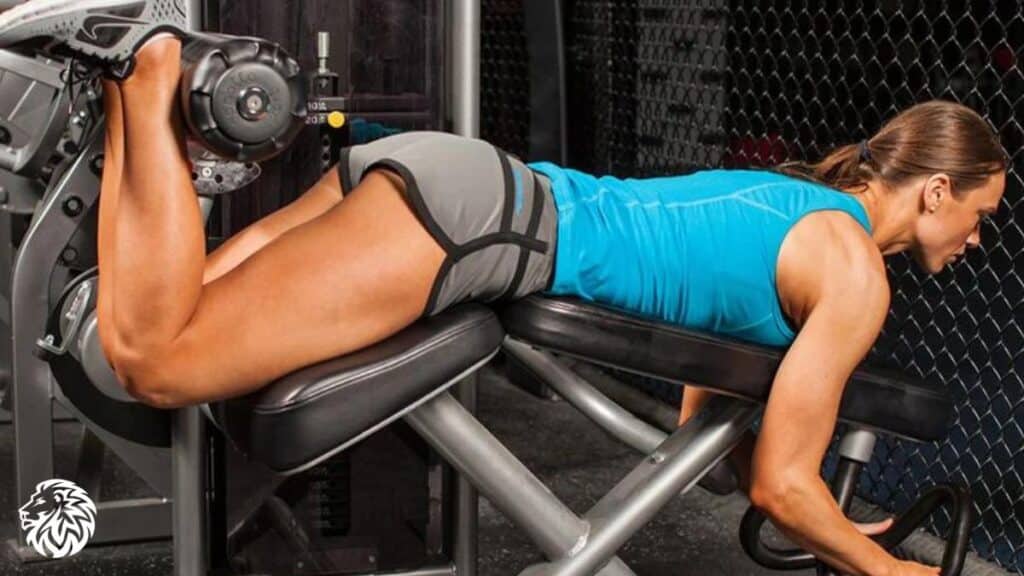
Equipment Needed: Lying leg curl machine.
Step-by-step Guide:
a. Lie face down on the machine, with your ankles positioned under the padded lever and your knees just off the edge of the bench.
b. Secure the lap pad against your thighs, just above your knees. Grasp the side handles for support.
c. Keeping your torso flat on the bench, curl your legs up as far as possible, aiming to bring your heels to your buttocks.
d. Pause briefly at the top of the movement, then slowly lower the weight back to the starting position, fully extending your legs.
Common Mistakes and How to Avoid Them:
a. Lifting your hips or torso off the bench: Maintain contact with the bench at all times to ensure you’re isolating the hamstring muscles.
b. Using momentum or speed to lift the weight: Perform the exercise slowly and controlled, focusing on the muscle contraction and release.
c. Not using full range of motion: Aim to fully extend and flex the knee on each rep to fully engage the hamstrings.
Exercise 3: Glute-Ham Raise
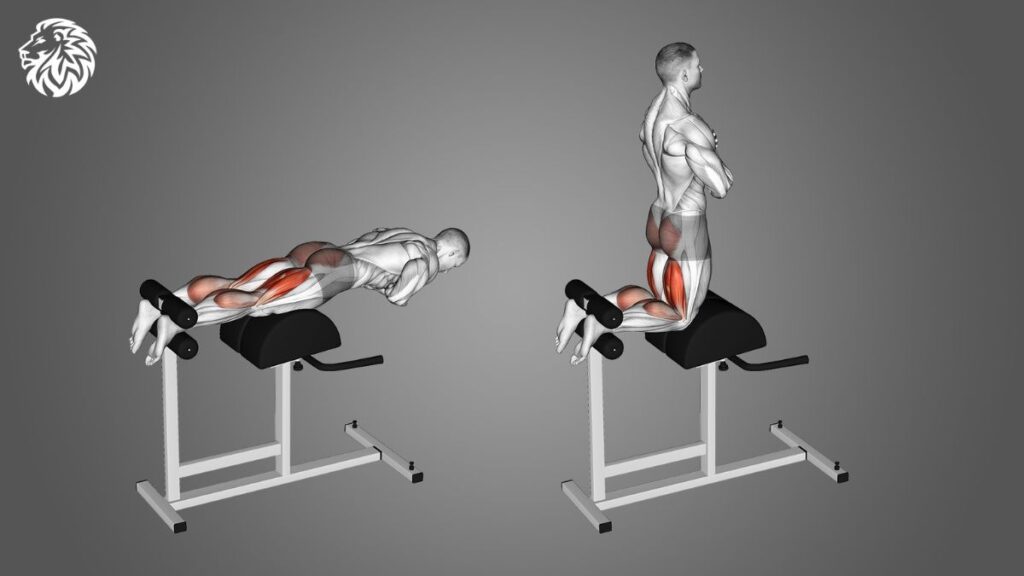
Equipment Needed: Glute-Ham Developer (GHD) machine.
Step-by-step Guide:
a. Adjust the GHD machine so that your feet are secured and your knees are just behind the pad when you kneel on it.
b. Start with your body in a straight line from knees to head, upright at a perpendicular angle to the ground.
c. Begin to lower your torso forward, maintaining a straight line from your knees to your head, by bending at the knees.
d. Lower yourself as far as you can control, then use your hamstrings and glutes to pull yourself back up to the starting position.
Common Mistakes and How to Avoid Them:
a. Hyperextending the back: Ensure your back remains in a straight line with your body throughout the movement.
b. Falling forward: It’s important to control the lowering phase of the movement to engage the hamstrings effectively.
c. Bending at the hips: The hinge point should be the knees, not the hips. Ensure you maintain a straight line from knees to head throughout the movement.
Exercise 4: Single-Leg Romanian Deadlift
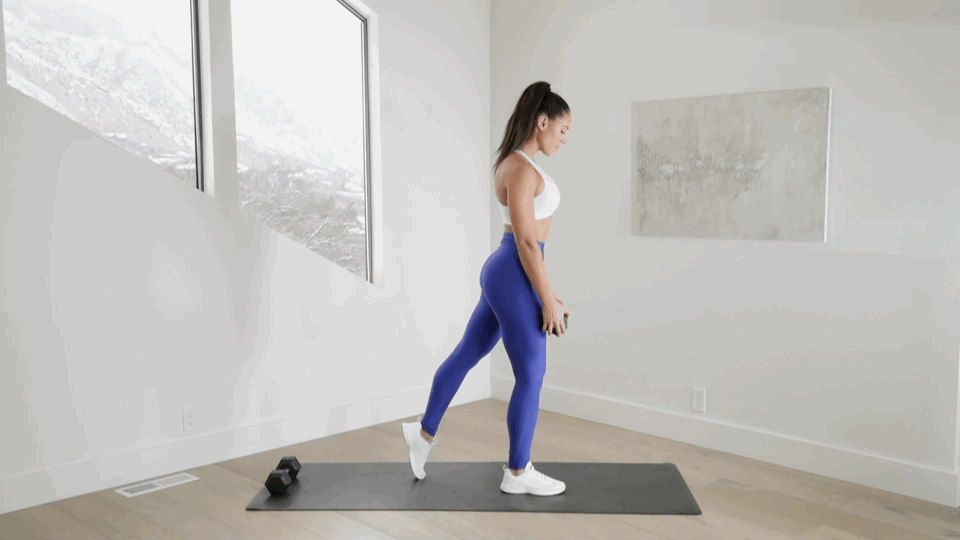
Equipment Needed: Dumbbell or kettlebell adjusted according to your strength level. This exercise can also be performed using a barbell for advanced users.
Step-by-step Guide:
a. Stand upright holding a dumbbell in your right hand. Lift your right foot slightly off the floor.
b. Hinge at your hips while extending your right leg straight behind you and lowering the dumbbell towards the floor. Keep your back straight and your left knee slightly bent.
c. Continue lowering the dumbbell until your body is parallel to the floor, or as far as your flexibility allows.
d. Reverse the motion by driving your hips forward and standing back up, maintaining balance on your left foot throughout.
e. Repeat the exercise for the desired reps, then switch to the other leg.
Common Mistakes and How to Avoid Them:
a. Rounding the back: Always engage your core and maintain a straight back throughout the movement. This helps protect your lower back from strain.
b. Losing balance: If you’re having trouble with balance, try focusing your gaze on a fixed point on the floor in front of you.
c. Moving too fast: This exercise requires control, especially as it involves balance. Make sure to perform the movement in a slow, controlled manner.
Weekly Workout Plan for Stronger Hamstrings
Day 1: Lower Body Workout
- Romanian Deadlift: 4 sets of 12 repetitions
- Lying Leg Curls: 4 sets of 15 repetitions
Day 2: Rest/Active Recovery
Day 3: Lower Body Workout
- Glute-Ham Raise: 3 sets of 10 repetitions
- Single-Leg Romanian Deadlift: 3 sets of 12 repetitions (each leg)
Day 4: Rest/Active Recovery
Day 5: Optional for Advanced Lifters
- Romanian Deadlift: 4 sets of 12 repetitions
- Lying Leg Curls: 4 sets of 15 repetitions
- Glute-Ham Raise: 3 sets of 10 repetitions
- Single-Leg Romanian Deadlift: 3 sets of 12 repetitions (each leg)
Day 6: Rest/Active Recovery
Day 7: Rest/Active Recovery
Remember, the goal is to strengthen your hamstrings gradually, so start with weights that you’re comfortable with and gradually increase as you get stronger. It’s crucial to maintain proper form during all exercises to avoid injury.
Conclusion
We’ve covered four significant hamstring exercises, from the Romanian Deadlift to the Single-Leg Romanian Deadlift, that can help you increase strength, enhance stability, and improve overall athletic performance. Hamstrings, often overlooked, play a vital role in many daily activities and most sports. By including these exercises on your leg day, you’re ensuring a well-rounded, balanced workout.
Fitness and strength-building are long-term commitments that require consistent effort. You may find these exercises challenging initially, but don’t be discouraged. Consistency is key. Focus on perfecting your form and gradually increasing intensity over time. Always remember, slow and steady wins the race in fitness progression. Keep at it, and you’ll notice improvements in strength, form, and overall performance.
Frequently Asked Questions
Why do I feel a strain in my lower back during Romanian Deadlifts?
You might be feeling strain in your lower back due to incorrect form. Ensure that you’re keeping your back straight and engaging your core during the movement. It’s also possible that the weight you’re using is too heavy, causing you to compromise on form. If the issue persists, consider seeking advice from a fitness professional.
I can’t seem to feel my hamstrings working during Lying Leg Curls, what am I doing wrong?
It’s possible that you’re moving too quickly or using momentum, rather than controlling the movement. Slow down, focus on the muscle-mind connection, and ensure you’re fully contracting and extending your legs. Additionally, make sure the weight isn’t too light, as this might not provide sufficient challenge for your hamstrings.
How often should I perform these hamstring exercises?
It depends on your overall fitness goals and workout routine. However, as a general guideline, incorporating these exercises into your leg day routine once or twice a week should be beneficial. It’s important to allow your muscles time to rest and recover between workouts.
Can I substitute any of these hamstring exercises if I don’t have access to a gym or specific equipment?
Absolutely! For instance, if you don’t have access to a gym for Lying Leg Curls, you can substitute with hamstring curls using a resistance band. Similarly, if you don’t have a barbell for Romanian Deadlifts, you can use dumbbells instead. Fitness is all about adaptability, and many exercises can be modified to fit the resources you have on hand.
I’m a beginner in strength training, are these hamstring exercises suitable for me?
Yes, these exercises can be suitable for beginners as long as they’re performed with proper form and appropriate weight. It’s essential to start with light weights to focus on mastering the form before gradually increasing the load. It’s always a good idea to consult with a fitness professional or trainer initially to ensure you’re performing these exercises correctly to prevent injury.







